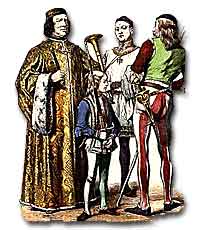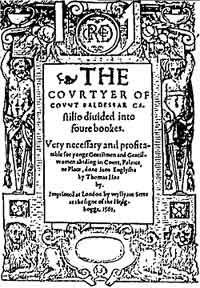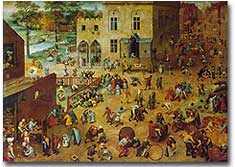| HOME |
Daily Life
If you lived in Italy during the Renaissance, how were you expected to behave and act? Actually, to become a part of the elite of Renaissance society, there were clear guidelines you had to follow. Many of these expectations were written down in books of etiquette. The most popular of these books was The Book of the Courtier, written by Baldassare Castiglione (1478-1529). In The Courtier, Castiglione outlined the proper behavior for men and women. For men, the goal was to become a Renaissance man, that is, talented in many areas. Men were expected to be able to participate in athletics, play musical instruments, dance gracefully, and engage in witty conversation. More important, they had to be familiar with the classical writings of Ancient Greece and Rome.
However, the Renaissance man wanted it to appear that these things came effortlessly to him. Men were to be confident but not boastful, assertive yet polite. Today, the term Renaissance man is still used to refer to someone who is knowledgeable in many subjects and skilled in a variety of activities. The expectations for women were somewhat different. Women, like men, studied the classics and were expected to participate in courtly conversation. Women did not engage in some of the rougher sports, but did practice needlepoint for example. Compared to their social position during the Middle Ages, women appear to have lost ground during the Renaissance. In terms of political power, work, and social influence clearly women were somewhat worse off. Furthermore, during the Middle Ages the code of chivalry generally held that men should try to please women.
Castiglione's The Courtier encouraged just the opposite: women were to please men. Women were expected to restrict their sexual activity to their husband exclusively. However, society did not disapprove of a husband's extramarital affairs. Many aspects of the modern world's conception of "traditional" women's roles were first introduced during the Renaissance. Today we recognize the Renaissance as a period of remarkable creativity. But, for the majority of the people at this time, life changed very little. Most still could not read. Few had knowledge of the literary aspects of the Renaissance. Only a small portion of society, the wealthy elite, had full access to all of the Renaissance's fruits. Almost 30% of the citizens of the cities were poor — many even beggars. The cities themselves grew larger but overall had changed little. Streets were now paved in cobblestone, but people continued to dispose of their waste by dumping it in the street. One can only begin to imagine the stench! |
|||||||
| MAIN | ||||||||
| WEBQUEST CENTRAL | ||||||||
|


